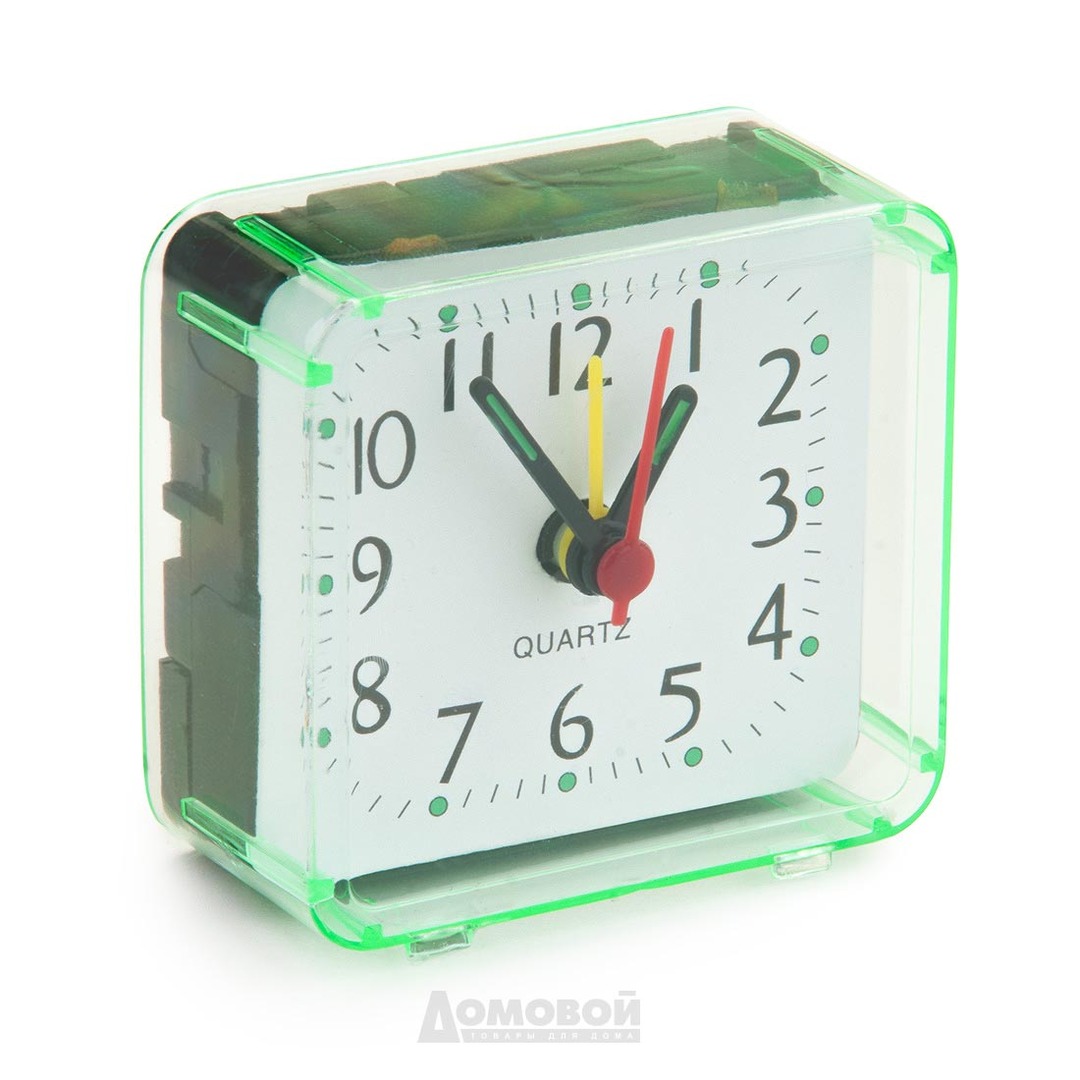To arrange a water supply in a private house or to organize automatic watering in a garden plot, you need to acquire a pumping station. The unit must be powerful enough to easily pump water from a well or well, economical and, if possible, inexpensive. How to choose such a device and which 5 pumping stations are worthy of the title of the best, we tell in this material.
CONTENT
- 1 How to choose a pumping station
- 2 Rating of the best pumping stations
- 3 FAQ
How to choose a pumping station
A pumping station differs from a conventional pump in that it can work in a fully automatic mode, providing water to your home or area. That is why pumping stations are used as a basis, say, for water supply or automatic irrigation. What to look for when choosing a pumping station?
Pump type. Pumping stations are equipped with single-stage vortex and multistage pumps. The difference between them is that in the first case there is only one impeller, and in the second there are several of them. Single-stage pumps are cheaper and easier to build, which means they are less likely to break down. Multi-stage - more complicated, more expensive, but at the same time quieter and more powerful.
Electric motor power. This parameter shows how much energy the pumping station will consume. This parameter does not directly affect performance - it all depends on the efficiency of the installed motor. However, according to this indicator, one can roughly judge how long the motor will last and how reliable it will be - low-power an engine that is constantly working at its limit is likely to kick in before a powerful engine that works half-heartedly. Typically, the capacity of pumping stations ranges from 0.5 to 1.5 kilowatts.
Suction depth. The higher this parameter, the more difficult the conditions the pump can operate. For example, if the suction depth is 10 meters, the pumping station will be able to pump water from an open reservoir or a shallow well. A depth of 20-30 meters is enough to use a station with an artesian well.
Ejector. This design element makes it possible to increase the force and depth of suction without increasing the power of the electric motor. The ejector can be built-in or remote. The first is located directly in the pump casing: it is quite noisy and not very efficient, but an inexpensive solution, which, as a rule, provides suction from a depth of 10-15 meters. The remote ejector is submerged directly into the water. A pump with a submersible ejector is quieter, and water can be sucked in from a depth of up to 30-50 meters, but this the structure is somewhat more difficult to operate and repair, it requires laying a second, recirculating pipe and costs expensive.
Hydroaccumulator. This word refers to a water storage tank. It is needed in order to maintain constant pressure in the system and not turn on the pump every time someone turns on the tap in the kitchen. The volume of the tank can be from 20 to 200 liters, but it should be borne in mind that water will not be there more than half - the rest of the volume is occupied by air, which allows you to maintain a constant pressure. The larger the accumulator, the better, of course. But at the price of a pumping station, it is the large tank that beats the most sensitively.
Aggression. It is measured as the height of the water column. To determine how much head you need, use a simple formula: H = Hn + Hi + L / 10 + Hd, where:
- Hn - water pressure in the system (usually in the region of 1.5-3 atmospheres),
- Hi - suction depth of the pumping station,
- L is the distance from the pump to the house,
- Hd is the height of the supply points (taps, showers, cisterns, etc.) above the supply line.
Performance. This parameter determines how much water a pumping station can supply per unit of time (usually it is measured in cubic meters per hour). To calculate the optimal performance, it is enough to add up the volume of water that is consumed by all delivery points. Approximate indicators are as follows:
- mixer - 0.6 cubic meters / h;
- shower - 0.8 cubic meters / h;
- toilet bowl with a cistern - 0.3 cubic meters / h;
- dishwasher - 0.6 cubic meters / h;
- washing machine - 0.7 cubic meters / h.
It makes no sense to overpay for excess power and head, because this means a pumping station with a more powerful motor, and therefore with a higher energy consumption.
Materials. The body, storage tank and working group of the pumping station can be made of different materials: plastic, steel, cast iron, aluminum, bronze, etc. Plastic is cheap and does not corrode, but it is a fragile and not particularly reliable material from which the housings of inexpensive pumping stations are made. Steel is distinguished by its moderate cost and high strength, but it is susceptible to corrosion - it is used for the manufacture of housings and accumulators of stations in the middle price category. Cast iron is heavy and rather brittle, but inexpensive and much less susceptible to corrosion than ordinary steel, so storage tanks are also made from it. Finally, non-ferrous metals such as aluminum, bronze or brass are almost non-corrosive, but they are quite decent, so they are used to make parts for pumping stations of the highest price category.
Automation. A special electronic relay is responsible for the pumping station to work independently and to regulate the pressure in the system itself. It is desirable that it be equipped with protection against dry running and overheating - this will ensure long-term and stable operation of the station.
Installation method. Pumping stations can be surface or buried. The first ones are installed on the surface of the earth: in a separate room or in a special pit - usually these are inexpensive options for home use. Buried pumping stations are distinguished by quiet operation and very high performance with a suction depth of up to 300 meters, they are expensive and are mainly used in the professional field.
Rating of the best pumping stations
The best pumping station with a suction depth of 10 meters
1. Metabo HWW 4000/25 G (1100 W)
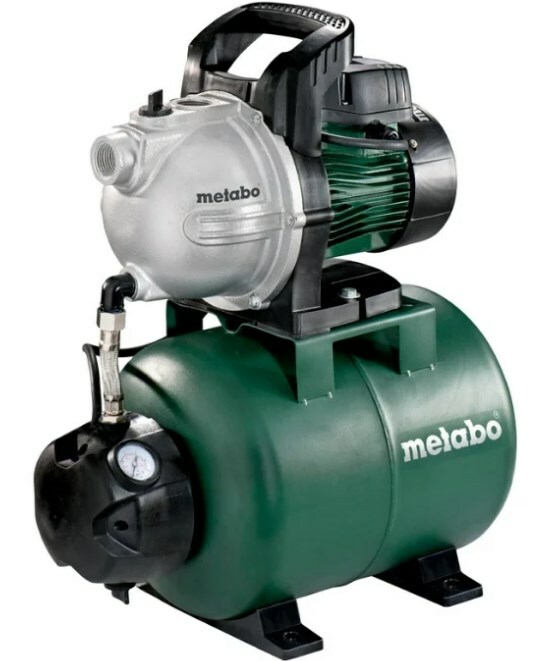
Surface type pumping station, designed for horizontal installation. The 1100 watt motor provides a suction depth of up to 10 m, a maximum head of 46 m wc and a capacity of 4 cu. m / hour. The capacity of the accumulator is 24 liters - enough for arranging a water supply system in a small house with a couple of residents or an automatic irrigation system. The case is made of pretty decent metal, but with plastic elements that tend to wear out rather quickly. Perhaps the main problem noted by almost all users is the high noise level. But at a price of 8,000 rubles for such a device, this does not seem like a big trouble.
Price:₽ 8 269
Metabo HWW 4000 25 G
The best pumping station with a suction depth of 20 meters
2. Denzel PSD800C (800W)
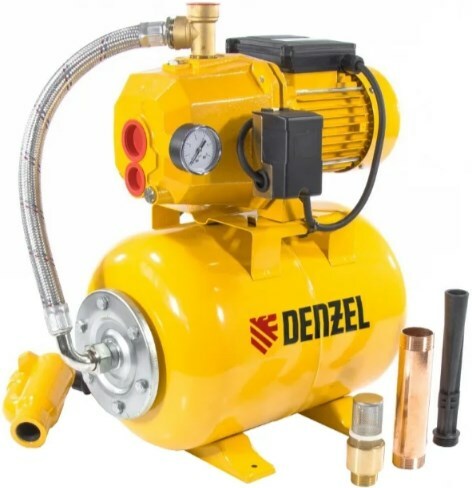
Surface mounted pumping station. Equipped with a remote ejector, which allows for a relatively low power and a modest price to provide suction from a depth of 20 meters. The 800-watt motor provides a maximum head of 45 meters of water with a capacity of 2.4 cubic meters per hour. The volume of the accumulator is 24 liters. The device is very decently assembled from high-quality materials and, unlike most analogs, even looks pretty. An external ejector provides a low noise level, so you can install the pumping station right in the house. The issue price is 10,700 rubles.
Price:₽ 10 755
Denzel PSD800C
The best pumping station with a suction depth of 30 meters
3. Marina APM 100/25 (1100 W)
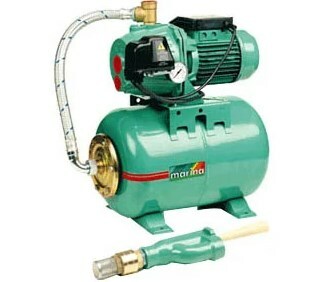
Not the most expensive, but extremely reliable and quite productive station for its 14,000 rubles. Designed for surface installation - an external submersible ejector is responsible for suction from a maximum depth of 25 meters (the depth to the water mirror is 8 meters). The centrifugal motor with a power of 1100 watts provides a stable performance of 2.4 cubic meters per hour, a maximum head of 20 meters of water. The volume of the water tank is 25 liters. This pumping station is undemanding to operating conditions and is capable of operating at full load for many years.
Price:₽ 14 158
Marina APM 100 25
The best pumping station for a well
4. JILEX Jumbo 70/50 P-50 (1100 W)
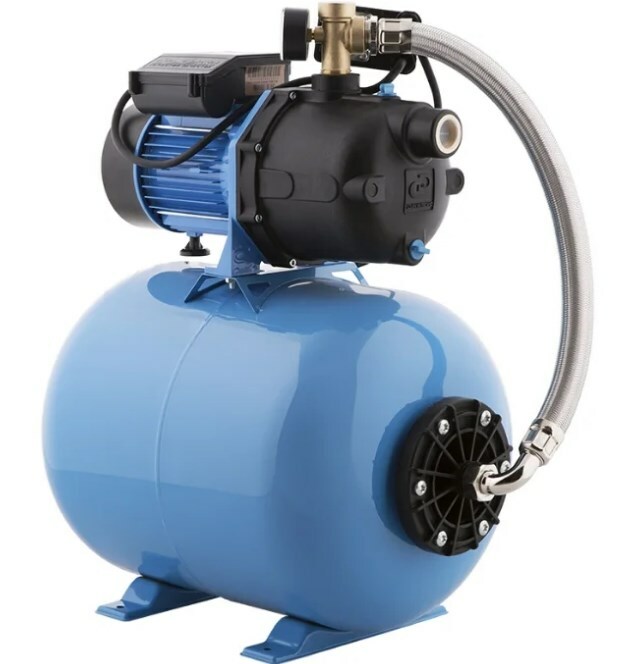
Surface pumping station with built-in ejector. A 1100 watt centrifugal pump produces 4.2 cubic meters of water per hour at a maximum head of 50 meters of water column. The maximum suction depth is 9 meters, which is more than enough for use in a well. The model is distinguished by a capacious accumulator with a volume of 50 liters. The pumping station is equipped with protection against dry running and overheating. The device, of course, works quite noisy, but this is a feature of all pumping stations with an ejector built into the body. The price of the issue is a rather modest 12,000 rubles. An excellent option for organizing water supply or watering in an area with a well.
Price:₽ 11 940
JILEX Jumbo 70 50 P 50
Best Miniature Pumping Station
5. AQUAROBOT M 24-15N (245 W) (4700r)
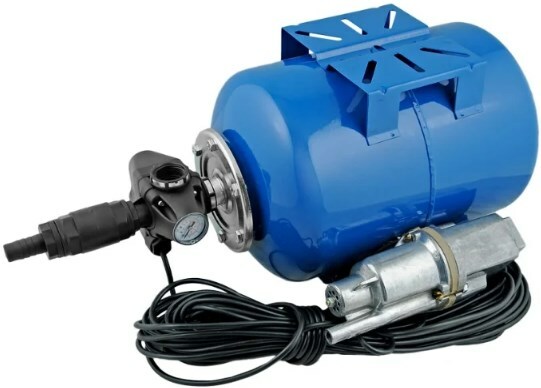
Surface pumping station with a 245 watt vibration pump. The throughput and maximum head, despite the modest power, are quite decent: 1.6 cubic meters per hour and 75 meters of water column, respectively. The volume of the hydraulic tank is 24 liters - a very common indicator for domestic pumping stations. But the length of the power cord is rather unusual - as much as 15 meters. Overheating protection is provided. Most likely, it will not work to arrange a water supply system in a mansion with the help of this baby for 5700 rubles, but for a small house or an area with a nearby source of water, it is perfect.
Price:₽ 5 697
AQUAROBOT M 24 15N
FAQ
Why doesn't the pumping station turn off and pump water?
Apparently, problems with automation. Fiddling with relays without the appropriate skills, most likely, does not make sense. The water supply line may be clogged. In any case, it is better to contact the service.
The pumping station is slowly gaining pressure - what is the reason?
There can be a lot of reasons. Garbage in the pipe or clogged ejector, insufficiently powerful and efficient motor, flying electronics - only the master can answer this question after diagnosing your equipment.
Read also:
The best pumps for wells


